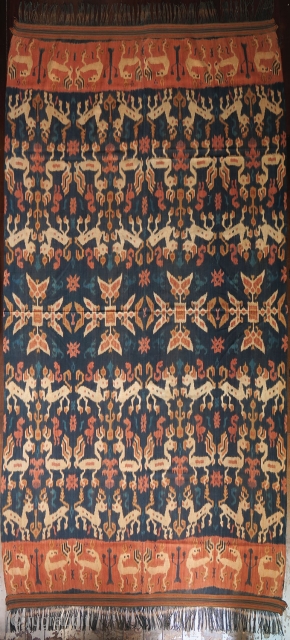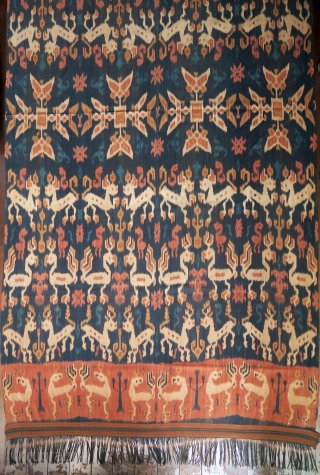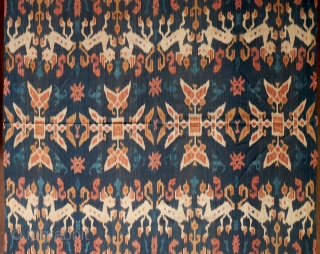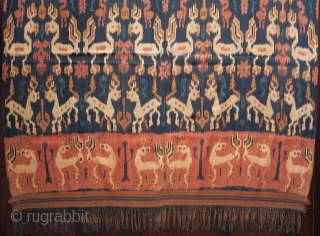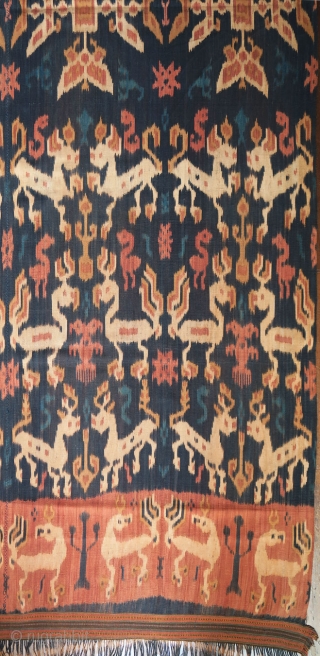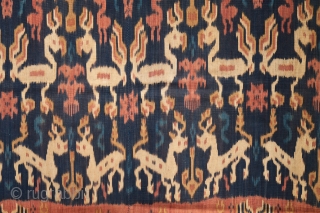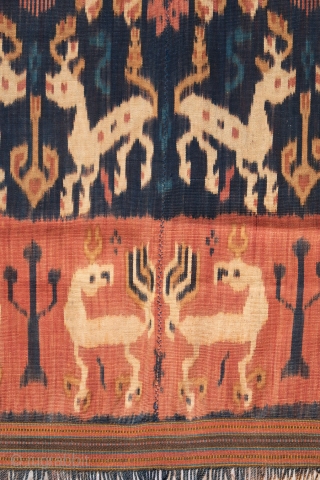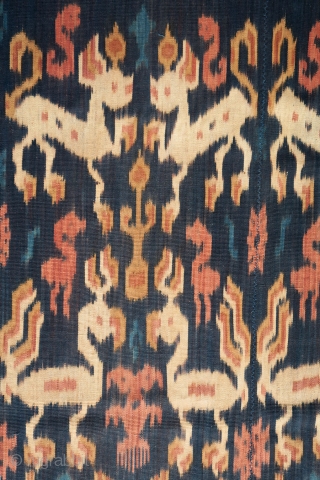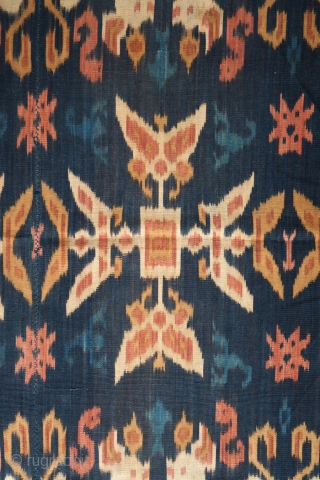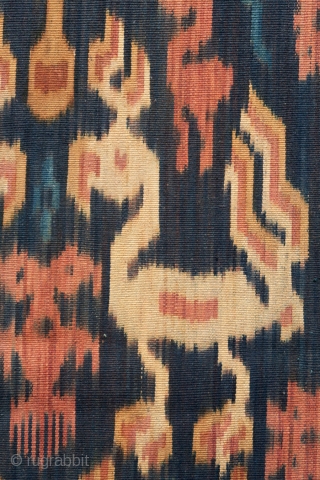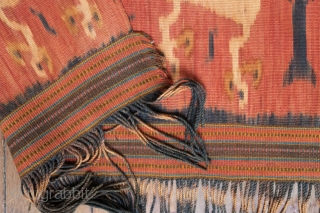Back
Sumba | Ikat Men’s Mantle with red dye (Hinggi Kombu)
Indonesia, East Sumba, Rende, before 1970
Handspun cotton, natural dyes, warp ikat, surface painting, twining
A gorgeous men’s mantle (hinggi) from Rende in east Sumba, woven with a rich variety of creatures in red, blue and yellow-brown warp ikat. The textile is made from 2 long mirroring panels joined together along the selvedge. Its motifs are arranged in 4 bands, also mirrored on either side of the central section of large flowers. The main motifs are similarly designed, creating repetition and variation: the 1st band has horses, the 2nd chickens, the 3rd deer, and the 4th another style of chickens. Filling the picture are smaller creatures and motifs in solid blue or red, whose darker tones give them the appearance of being recessed. The artistry of the weaver is displayed by the perfect alignment of 2 halves of small geometric motifs joined at the seam.
The central section presents a stately, grand treatment of the patola motif, animated by small blue crayfish. In the last contrasting red band, the chickens’ combs and feet have been painted in yellow. The textile is finished with the characteristic band called a kabakil: a border of weft-wise rib woven on a special small loom, using the warps of the ikat as the wefts of the kabakil. Warps in red, blue, and white were used to create a nicely textured border with stripes and dots, and the piece was then twined into the base of the cloth. Of particular note is the high quality of the ikat tying, which is unusually sharply defined for Sumbanese ikat. The carefully twisted floppy fringes have also been ikatted.
Context: Textiles from east Sumba have traditionally been major status markers for the noble caste throughout the island, who at one time had the sole right to wear decorated textiles. Their exchange substantiates alliances between clans, and is necessary to the rituals of the local animist belief system (Marapu). Large quantities are required as prestige clothing and gifts on ceremonial and ritual occasions—a high ranking Sumbanese may be wrapped and buried in over 100 hinggi, that will protect the soul from malevolent forces, and identify the deceased (by motifs, colors, and quality) to ancestors in the next world (Jill Forshee, “Unfolding Passages”, in Decorative Arts of Sumba, 33-39).
Cloth carries cosmological and social symbols, marking clan, gender, rank, and ancestral affiliation. Animals are both literally a part of great social ceremonies, and, as motifs on cloth, symbolize the wearer’s qualities. Horses symbolize courage in warfare, nobility, and wealth, and are often sacrificed at funerals of high-ranking persons to accompany them to the next world. Large deer, like horses, are referred to as belonging to the king—only the nobility could organize a deer hunt as part of the sacred rites of the dry season, and large upstanding headdresses resembling deer’s antlers were exclusive to royalty in Sumba. Sea worms mark the end of the wet season by coming ashore, heralding the start of the pasola horse joust festival; they are believed to represent the body of the Princess Nyale, daughter of the king of the Moon, who sacrificed herself to ensure the fertility of the soil in Sumba. (Djajasoebrata & Hanssen, Decorative Arts of Sumba, 55).
Condition: The mantle is in excellent condition, with no holes, stains or tears. The colors are all rich and fresh, with warm, lively tones. The handspun cotton is of quite heavy and densely woven, with a grainy hand.
Length: 260 cm plus 10 cm fringes at each end. Width: 126 cm.
Indonesia, East Sumba, Rende, before 1970
Handspun cotton, natural dyes, warp ikat, surface painting, twining
A gorgeous men’s mantle (hinggi) from Rende in east Sumba, woven with a rich variety of creatures in red, blue and yellow-brown warp ikat. The textile is made from 2 long mirroring panels joined together along the selvedge. Its motifs are arranged in 4 bands, also mirrored on either side of the central section of large flowers. The main motifs are similarly designed, creating repetition and variation: the 1st band has horses, the 2nd chickens, the 3rd deer, and the 4th another style of chickens. Filling the picture are smaller creatures and motifs in solid blue or red, whose darker tones give them the appearance of being recessed. The artistry of the weaver is displayed by the perfect alignment of 2 halves of small geometric motifs joined at the seam.
The central section presents a stately, grand treatment of the patola motif, animated by small blue crayfish. In the last contrasting red band, the chickens’ combs and feet have been painted in yellow. The textile is finished with the characteristic band called a kabakil: a border of weft-wise rib woven on a special small loom, using the warps of the ikat as the wefts of the kabakil. Warps in red, blue, and white were used to create a nicely textured border with stripes and dots, and the piece was then twined into the base of the cloth. Of particular note is the high quality of the ikat tying, which is unusually sharply defined for Sumbanese ikat. The carefully twisted floppy fringes have also been ikatted.
Context: Textiles from east Sumba have traditionally been major status markers for the noble caste throughout the island, who at one time had the sole right to wear decorated textiles. Their exchange substantiates alliances between clans, and is necessary to the rituals of the local animist belief system (Marapu). Large quantities are required as prestige clothing and gifts on ceremonial and ritual occasions—a high ranking Sumbanese may be wrapped and buried in over 100 hinggi, that will protect the soul from malevolent forces, and identify the deceased (by motifs, colors, and quality) to ancestors in the next world (Jill Forshee, “Unfolding Passages”, in Decorative Arts of Sumba, 33-39).
Cloth carries cosmological and social symbols, marking clan, gender, rank, and ancestral affiliation. Animals are both literally a part of great social ceremonies, and, as motifs on cloth, symbolize the wearer’s qualities. Horses symbolize courage in warfare, nobility, and wealth, and are often sacrificed at funerals of high-ranking persons to accompany them to the next world. Large deer, like horses, are referred to as belonging to the king—only the nobility could organize a deer hunt as part of the sacred rites of the dry season, and large upstanding headdresses resembling deer’s antlers were exclusive to royalty in Sumba. Sea worms mark the end of the wet season by coming ashore, heralding the start of the pasola horse joust festival; they are believed to represent the body of the Princess Nyale, daughter of the king of the Moon, who sacrificed herself to ensure the fertility of the soil in Sumba. (Djajasoebrata & Hanssen, Decorative Arts of Sumba, 55).
Condition: The mantle is in excellent condition, with no holes, stains or tears. The colors are all rich and fresh, with warm, lively tones. The handspun cotton is of quite heavy and densely woven, with a grainy hand.
Length: 260 cm plus 10 cm fringes at each end. Width: 126 cm.
price:
SOLD
- Home
- Antique Rugs by Region
- Category
- Profiles
- Post Items Free
- Albums
- Benaki Museum of Islamic Art
- Budapest: Ottoman Carpets
- Gulbenkian Museum
- Islamic Carpets. Brooklyn
- Islamic Textiles. Brooklyn
- Konya Museum: Rugs
- MKG, Hamburg
- MMA: Caucasian Carpets
- MMA: Mamluk Carpets
- MMA: Mughal Indian Carpets
- MMA: Ottoman Carpets
- MMA: Safavid Persian Carpets
- MMA: Turkmen Rugs
- McCoy Jones Kilims
- Ottoman textiles. Met
- Philadelphia Museum
- Rugs and Carpets: Berlin
- Seljuqs at the Met
- TIEM, Istanbul: Carpets
- V&A: Classical Carpets
- Vakiflar Carpets: Istanbul
- Baluch Rugs: Indianapolis
- Gallery Exhibitions
- Jaf an Exhibition
- Alberto Levi Gallery
- Andean Textile
- Christie's London: 2016
- Francesca Galloway
- HALI at 40
- ICOC Washington, DC 2018
- Jajims of the Shahsavan
- London Islamic Week April, 2018
- Mongolian Felts
- Navajo Rugs: JB Moore
- Persian Piled Weavings
- SF Tribal & Textile Art Show 2020
- SF Tribal 2019
- Sotheby's: C. Alexander
- Turkish Prayer Rugs
- Turkmen Main Carpets ICOC 2007










